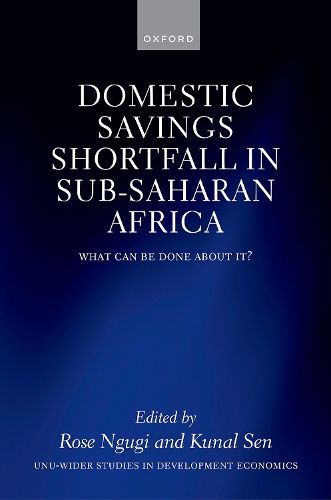Readings Newsletter
Become a Readings Member to make your shopping experience even easier.
Sign in or sign up for free!
You’re not far away from qualifying for FREE standard shipping within Australia
You’ve qualified for FREE standard shipping within Australia
The cart is loading…






This is an open access title available under the terms of a CC BY-NC-SA 3.0 IGO licence. It is free to read at Oxford Scholarship Online and offered as a free PDF download from OUP and selected open access locations.Domestic Savings Shortfall in Sub-Saharan Africa aims to increase knowledge about the key drivers of domestic saving rates in Sub-Saharan Africa (SSA), as well as whether alternative approaches, such as pension funds or fintech, could provide new solutions to increase domestic savings. The book also examines the lessons learnt from the experiences so far in different countries in SSA, and what can SSA learn from the experience of other regions which have been more successful in raising savings rates. The book consists of two parts: thematic studies and country studies. The thematic studies examine the implications of new developments in African financial markets on savings behaviour, the role of sovereign wealth funds, pensions, and capital markets in augmenting savings and in economic development, the challenges of the debt crisis in Africa, the implications of financial liberalization for private saving in SSA, and lessons on how to increase savings rates from East and South Asia. The four country studies-Tanzania, Cameroon, and Ghana-examine the determinants of domestic savings. The countries were selected based on criteria that capture the diversity of savings performance in SSA. Each case study uses a common conceptual framework drawn from the life-cycle theory of savings and the same empirical methods to test for the determinants of savings using time-series data for the country in question. The findings of the book provide clear recommendations on how to increase savings in Sub-Saharan Africa.
$9.00 standard shipping within Australia
FREE standard shipping within Australia for orders over $100.00
Express & International shipping calculated at checkout
This is an open access title available under the terms of a CC BY-NC-SA 3.0 IGO licence. It is free to read at Oxford Scholarship Online and offered as a free PDF download from OUP and selected open access locations.Domestic Savings Shortfall in Sub-Saharan Africa aims to increase knowledge about the key drivers of domestic saving rates in Sub-Saharan Africa (SSA), as well as whether alternative approaches, such as pension funds or fintech, could provide new solutions to increase domestic savings. The book also examines the lessons learnt from the experiences so far in different countries in SSA, and what can SSA learn from the experience of other regions which have been more successful in raising savings rates. The book consists of two parts: thematic studies and country studies. The thematic studies examine the implications of new developments in African financial markets on savings behaviour, the role of sovereign wealth funds, pensions, and capital markets in augmenting savings and in economic development, the challenges of the debt crisis in Africa, the implications of financial liberalization for private saving in SSA, and lessons on how to increase savings rates from East and South Asia. The four country studies-Tanzania, Cameroon, and Ghana-examine the determinants of domestic savings. The countries were selected based on criteria that capture the diversity of savings performance in SSA. Each case study uses a common conceptual framework drawn from the life-cycle theory of savings and the same empirical methods to test for the determinants of savings using time-series data for the country in question. The findings of the book provide clear recommendations on how to increase savings in Sub-Saharan Africa.